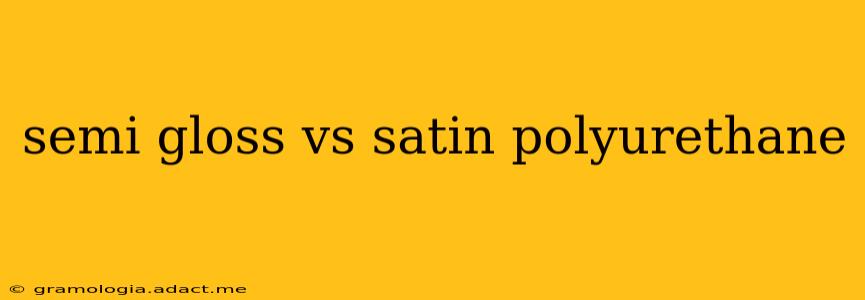Choosing between semi-gloss and satin polyurethane can feel overwhelming. Both offer excellent protection for your wood finishes, but their subtle differences in sheen significantly impact the final look and feel. This guide will help you understand the key distinctions and determine which option best suits your needs.
What is Polyurethane?
Before diving into the differences, let's establish what polyurethane is. Polyurethane is a durable, protective coating commonly used on wood furniture, floors, and other surfaces. It forms a hard, clear layer that resists scratches, water damage, and wear and tear. The key difference between semi-gloss and satin lies in their level of shine or "sheen."
Semi-Gloss Polyurethane: A Balanced Approach
Semi-gloss polyurethane offers a moderate level of shine, falling between high-gloss and satin. It's a popular choice for many projects because it strikes a balance between durability and a less reflective surface.
Advantages of Semi-Gloss Polyurethane:
- Good durability: Offers strong protection against scratches and wear.
- Moderate shine: Provides a noticeable sheen without being overly glossy or reflective.
- Hides imperfections: The slight shine helps to mask minor surface flaws in the wood.
- Easy to clean: Its smooth surface is relatively easy to wipe clean.
Disadvantages of Semi-Gloss Polyurethane:
- More noticeable imperfections: While it hides some flaws, significant imperfections will still be visible.
- May show fingerprints: More prone to showing fingerprints than a higher gloss finish.
Satin Polyurethane: A Subtle Shine
Satin polyurethane has a lower sheen than semi-gloss, creating a more subdued and elegant finish. It's often preferred for projects where a less reflective surface is desired.
Advantages of Satin Polyurethane:
- Subtle elegance: Provides a soft, understated sheen that complements many styles.
- Hides imperfections better than semi-gloss: The lower shine effectively masks surface imperfections.
- Less reflective: Reduces glare and reflections, making it suitable for areas with bright lighting.
- Warm, natural look: Gives wood a more natural and less plasticky appearance.
Disadvantages of Satin Polyurethane:
- Slightly less durable: While still durable, it might show scratches more easily than semi-gloss.
- May require more coats: May require more coats for full coverage compared to semi-gloss.
Which Sheen is Right for You? Considering Your Project
The best choice depends entirely on your project and personal preferences. Here's a breakdown to guide your decision:
Semi-Gloss is best for:
- High-traffic areas: Kitchen cabinets, dining room tables, frequently used furniture.
- Projects where durability is paramount: Floors, outdoor furniture (with UV protection added).
- A slightly more modern look: Offers a cleaner, more contemporary feel.
Satin is best for:
- Fine furniture: Dressers, antique pieces, delicate woodwork.
- Projects where a subtle, natural look is desired: Bedroom furniture, living room pieces.
- Areas with bright lighting: Reduces glare and reflections, minimizing distractions.
How to Apply Polyurethane (Both Semi-Gloss and Satin)
The application process for both sheens is essentially the same. Always follow the manufacturer's instructions, but generally, you'll need:
- Clean, sanded surface: Ensure your wood is properly prepared.
- Quality brushes or sprayers: Depending on your preference and project size.
- Thin coats: Apply multiple thin coats rather than one thick coat. Allow each coat to dry completely before applying the next.
Frequently Asked Questions (FAQ)
Can you mix semi-gloss and satin polyurethane?
Mixing different sheens is generally not recommended, as it can lead to an inconsistent finish. It's best to stick with one type for a uniform look.
Which is easier to clean?
Both are relatively easy to clean, but semi-gloss might be slightly easier due to its smoother, less porous surface.
Which is better for outdoor use?
For outdoor use, you'll need a polyurethane specifically formulated for exterior applications, regardless of sheen. Look for products that offer UV protection to prevent fading and damage from sunlight.
Which hides scratches better?
Semi-gloss tends to hide minor scratches better than satin due to its higher gloss level. However, significant scratches will be visible regardless of sheen.
By carefully considering these factors and understanding the nuances of each finish, you can choose the perfect polyurethane sheen to beautifully protect and enhance your woodworking projects.
